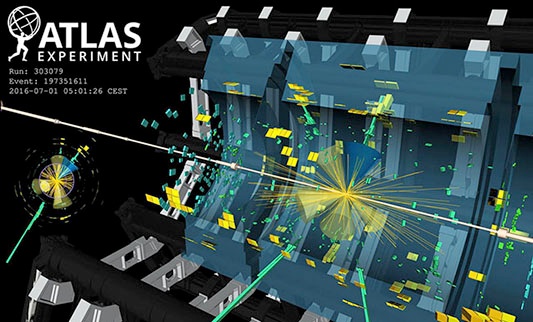The Institute of Corpuscular Physics (IFIC, CSIC-Universitat de València) participates in an international research that is presented today and addresses the interaction of the Higgs Boson, which is the responsible of the mass of elemental particles; with the quark top, the heaviest known particle. This study, carried out using artificial intelligence techniques, is important know how particles acquire mass and it’s a way to search “new physics” in the largest particle accelerator in the World, the Large Hadron Collider (LHC) of the CERN.
The Higgs Boson is the responsible particle of the mass of the rest of elemental particles. It only interacts with mass particles. This is the reason why it is important to study its relationship with the heaviest known particle, the quark top. The most direct manifestation of this relation is the emission of a Higgs Boson by a quark top with its anti-particle, a quark anti-top. The new results that describe these phenomena, called process of production ttH”, are presented today at a conference in Bologna (Italy). The results of this process were obtained by the experiments of LHC ATLAS and CMS and they had a statistically superior significance than five sigma (it is the threshold to proclaim a genuine discovery). They were published today in the magazine Physical Review Letters.
These results are a great advance in the study of the properties of the Higgs Boson, which was discovered in the LHC in 2012. The discoveries of both experiments are compatible and agree with the predictions of the Standard Model, which is the theory that describes the particle elements and its interactions and offers new clues on the search of “new physics”.
Measuring this process is a challenge because it does not usually take place: only 1% of Higgs blosons produced in the LHC are linked to two quarks top. In addition, the Higgs Boson and the quarks top are split in other complex particles. The collaborations of ALTAS and CMS have carried out several independent studies in the process of ttH production. They were focused on several ways splitting the Higgs with data of the collisions among protons of the LHC obtained during several years with energies of 7, 8 and 13 teraelectron volts.
María Moreno Llácer is a fellow of the CERN that carried out her doctoral programme in the Institute of Corpuscular Physics (IFIC, CSIC-Universitat de València) and participates in the theses analysis. The difficulty of observing the interaction between the Higgs Boson and the quark tops is based on dismissing many other similar processes that produce the collisions in the LHC. In this sense, we use advance technical statistic techniques to explore the data by means of automatic learning processes that are generally called machine learning o Artificial Intelligence to distinguish the final results of the splits that concern us among the many produced” states Moreno.
It is very important for the research in the IFIC to understand how the interactions between the Higgs boson and the quark top are produced. “As it is the heaviest elemental particle, it is very interesting to know how the quark top interacts with the Higgs Boson, which is the responsible of the mass of all the particles. This connection is more intense. In addition, if there is new physics, it has to have an enormous and very energetic mass, so that studying this process can give us the clues to its existence. However, it is still a mystery why quark top is more massive than the particle itself that gives the mass to the rest of elemental particles” concludes Moreno.
The researcher was part of the IFIC group specialised in the study of quark top in the experiment ATLAS. Ximo Poveda Torres, who is currently working in the CERN, was a member of the IFIC group that analysed the Higgs Boson. In the last years, both of them have been focused in this analysis whose results are presented today. The researchers of the group ATLAS of IFIC participate actively in quark top and Higgs Boson physics studies. They measure the precision of its interactions and its properties and look for new phenomena. Several members of IFIC have been in charge at different levels of the coordination within the collaboration with ATLAS in study of the quark top and the Higgs Boson. ATLAS is formed by over 3,000 physics around the world.
This result is produced by the perfect procedure of LHC, the efficiency of ATLAS and finals CMS detectors, and the use of advanced techniques of analysis and the inclusion in those analyses of every possible final state of the splitting particles. Nonetheless, the precision of these particles leaves room for the new physics. In the following years, two experiments will seek out a lot of data related to the improvement of the LHC in 2025 (High Luminosity LHC or HL-LHC). It will improve the efficiency of these measures to confirm that Higgs can reveal the existence of physics beyond the Standard Model.


